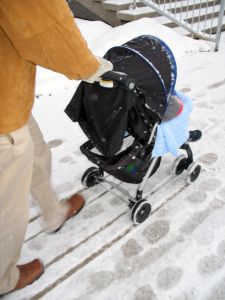By Linda Acredo, PhD, and Susan Goodwyn, PhD, co-founders of the Baby Signs® Program
 Lisa Smith, a young mother of two little girls, was at her wits end, and very worried. She knew enough about child development to understand that things weren’t going well between her and her six-month-old daughter, Melissa.
Lisa Smith, a young mother of two little girls, was at her wits end, and very worried. She knew enough about child development to understand that things weren’t going well between her and her six-month-old daughter, Melissa.
In stark contrast to her experience with first-born Laura, whose sunny disposition made parenting a joy, Melissa seemed to have come into the world with a chip on her shoulder. So easily frustrated was she that much of Lisa’s day was spent trying to figure out how to quiet her crying. It wasn’t colic, according to the pediatrician – just a fussy temperament that Lisa would have to learn to live with, and love. And that’s what had Lisa worried. Instead of feeling unconditional love for Melissa, she was feeling more and more frustration and resentment – emotions that she feared Melissa was feeling, too.
The Very Important First Two Years
The importance of loving your children is not earth-shattering news. What may be news to many parents, however, is the certainty with which researchers point to the first two years of life as especially critical – as the time when a child’s basic outlook on the world is forming. What’s more, research has also shown that, without a doubt, the factor most predictive of a positive outlook is a healthy and happy caregiver-infant bond.
That’s where the word “attachment” comes in. This is the term used by child psychologists to label the emotional bond that forms between children and the significant adults in their lives starting soon after birth. We’re indebted to a British clinical psychologist, Dr. John Bowlby, for discovering the critical nature of this early bond. Based in part on the emotional damage he had seen among refugee orphans from World War II, as well as on children in his own clinical practice, Bowlby became convinced that the first two years of a child’s emotional life were not only relevant, but absolutely critical to future emotional well-being.
When that bond is positive in nature, enabling children to trust a parent as a source of comfort and safety, the attachment is called “secure.” In contrast, when the bond is problematic, when children do not view a parent as trustworthy, the attachment is called “insecure.”
What every parent hopes for is a secure attachment with their baby. But how does a parent go about making sure that happens?
Thanks to Bowlby’s colleague, Dr. Mary Ainsworth, we now know that two of the most important ingredients are “sensitivity” and “responsiveness” on the part of the parent. In other words, the ability to read the baby well (know what he or she needs) and the willingness to meet those needs in a timely fashion.
The bottom line of the attachment relationship: Children fall in love with those who meet their physical needs for food and warmth, comfort them when they are hurt, protect them when they are frightened, and, in general, make them feel respected, understood, and loved.
How Baby Signing Can Strengthen The Parent-Child Bond
Few of these wonderful words described Lisa and Melissa’s relationship. With both mother and baby experiencing daily doses of frustration and resentment, the danger of an insecure attachment was looming large. But that’s not what happened! Instead, the relationship began a dramatic turnaround in a matter of months, a change that Lisa credits to the introduction of signing into their interactions with Melissa.
Specifically, Lisa began modeling signs that she thought her daughter might be able to use to communicate her needs more effectively – that is, without having to resort to crying. And it worked!
The success Lisa had comes as no surprise, given our decades of research on the benefits of signing with hearing babies – research conducted at the University of California with the help of funds from the National Institutes of Health in Washington, D.C. In addition to data proving that signing accelerates, rather than hinders, verbal development and promotes intellectual progress, we had also uncovered convincing evidence that signing contributes significantly to the formation of a positive relationship between parent and child in the first years of life.
As adults, we tend to forget what a complicated job babies face when they want to learn to talk. Unfortunately, until babies can conquer all the intricate movements necessary for speech, they are literally at a loss for words to tell us what’s on their minds. Learning to use simple signs bypasses all these obstacles, enabling babies to communicate effectively months earlier than would be possible were they to wait for words.
A secure attachment is based on a baby experiencing lots of good times with parents relative to the number of frustrating and anxiety-ridden times. Anything that increases the number of positive interactions and decreases the number of negative interactions is going to help parent and child forge a healthy relationship. And this is exactly what signs do. Here’s how:
- Because signs make the task of “reading” the baby so much easier, they help parents meet their baby’s needs efficiently, reducing everyone’s frustration and decreasing tears and tantrums.
- Parents who are watching for signs are paying closer attention to whatever their baby does, thus increasing the chance that even non-sign signals will be detected and responded to appropriately.
- Signs help parents learn that their baby is fully capable of feeling loved and secure or anxious and rejected. That knowledge leads to the understanding that it really matters what a parent does.
- Signs enable babies to share their worlds with their parents, thereby increasing the joy that each takes in the other’s company.
Baby Signing Isn’t Difficult to Learn…or to Teach
People who first hear about signing with babies think that it must be difficult to do, that it’s too much to add to a frazzled parent’s busy day. Nothing could be further from the truth. All that’s necessary is to do the same thing parents do to teach their babies to wave “bye-bye”: Simply say the word while modeling the motion as the baby watches. Repeat the pairing of the word and the sign frequently and, after babies have witnessed enough of these episodes, they begin to use the sign themselves.
A Real-Life Example
So, how did signs help Lisa and Melissa? According to Lisa: “As soon as Melissa began to sign, like magic, everything began to change. My husband, Wayne, noticed it, too. Finally, Melissa could let me know what she needed or wanted without crying all the time. She seemed as relieved as we were!
“And beyond that, she really enjoyed letting us know when she saw things she thought were neat,” Lisa continued. “One time in the park. we saw a boy with a big dog. They were playing with a soccer ball. I just assumed she’d be interested in the dog, so I started talking about it. But then she made the sign for ‘ball’ and smiled when I said, ‘Oh! You see the ball!’ When I started talking about the ball instead, she relaxed back in her strolling and really seemed to listen.”
“Things like that happened every day,” Lisa concluded. “Wayne and I were absolutely enchanted and, for just about the first time, we were actually eager to spend time with her. I really hate to think what our relationship would be like today if it hadn’t been for the signs.”
© 2008 BABY SIGNS, INC.
About the Baby Signs® Program
Drawing extensively from American Sign Language (ASL), the Baby Signs® Program teaches parents how to help their babies communicate using simple movements like fingers to lips for EAT, finger tips tapped together for MORE, and fist opening and closing for MILK. With signs like these and many more, babies can let parents know that they are hungry, thirsty, need more of something, or even that they feel feverish (HOT) or are experiencing pain (HURT). In addition to helping babies get their needs met, signing also enables babies to share the joys of their worlds with their parents. Babies are fascinated by what they see and hear as they move through their days and want their parents to share in their discoveries. Having simple signs to point out the BUTTERFLY in the garden, the CAT hiding in the bushes, or the DOG they hear barking outside provides babies a way to do just that. For more information, visit www.babysigns.com.


 According to an article on the United Arab Emirates’ TheNational.ae, “More than Sadness,” the rate of children with depression in the UAE is on the rise.
According to an article on the United Arab Emirates’ TheNational.ae, “More than Sadness,” the rate of children with depression in the UAE is on the rise. I don’t know why, as adults, we think we know everything. Maybe we just automatically subscribe to the theory that as we get older, we get wiser. What I think actually happens is we become more jaded, and we mistake that for knowledge. I think we all agree that age does not teach us. Experience does. That’s why some of my most powerful learning experiences have come from folks far younger than me – but wise beyond their years.
I don’t know why, as adults, we think we know everything. Maybe we just automatically subscribe to the theory that as we get older, we get wiser. What I think actually happens is we become more jaded, and we mistake that for knowledge. I think we all agree that age does not teach us. Experience does. That’s why some of my most powerful learning experiences have come from folks far younger than me – but wise beyond their years. It is now clear that a child can learn in every social interaction, anywhere. The more a child interacts, the more the child will learn, communicatively and cognitively. The key factor is for the child to have many one-on-one partners who act and communicate in ways the child is capable of and interested in.
It is now clear that a child can learn in every social interaction, anywhere. The more a child interacts, the more the child will learn, communicatively and cognitively. The key factor is for the child to have many one-on-one partners who act and communicate in ways the child is capable of and interested in.



